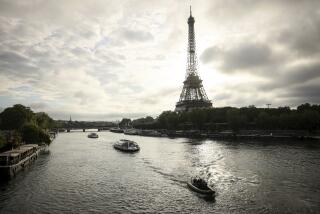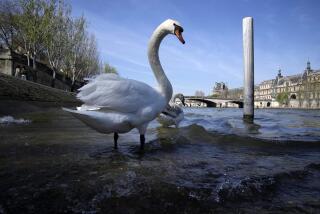Crowd of Highlights on the Rhine
- Share via
COLOGNE, Germany — Few great rivers evoke the mystery and myth that surrounds the Rhine.
Perhaps that is why the idea of a Rhine cruise is still a lure to travelers, even in an age when the river is as congested and despoiled as any superhighway.
The Rhine begins in eastern Switzerland’s Grisons canton, where the Vorderrhein and the Hinterrhein meet to form the Alpine Rhine. It ends in Holland’s North Sea. And, from beginning to end, its murky depths and rocky shores have inspired poets, tale spinners and diarists since the dawn of recorded history.
Sir Arthur Conan Doyle dispatched Sherlock Holmes in the Rhine, sending him tumbling over the Rheinbeck Falls at Schauffhaussen, Switzerland, locked in mortal combat with his eternal foe, Professor Moriarty.
Earlier, when the Roman Empire was just beginning to forge the great Roman Road adjacent to the banks of the Rhine, Julius Caesar wrote that the barbarian tribes who lived there ate fish and bird’s eggs for sustenance.
Playwright Lillian Hellman used the Rhine’s symbolic position as a natural border between Germany and France to express her anti-Nazi sentiments in the play, “Watch on the Rhine.”
And in “Childe Harold’s Pilgrimage,” Lord Byron writes of the Drachenfels--a lonely, crumbling castle sitting on a hill overlooking the right bank of the Rhine in Germany. Smack in the middle of a region known for its fine red wine (called “dragon’s blood”), tourists can ascend to the ruin via a 19th-Century rack railway.
Most of the land that borders the Rhine in its 825-mile journey to the sea has some historic, mythic or political significance. And the hardy traveler can partake of these sites by booking onto any one of the three- to six-day Rhine cruises offered by the KD German Rhine Line/Elba River Cruises (800) 858-8587 or (415) 392-8817, the oldest and primary provider of tourist travel on the Rhine.
But perhaps the area most often associated with the phrase “Rhine cruise” is the so-called Middle Rhine, that part of the river stretching from Mainz to Cologne in Germany--the Rhine of composer Richard Wagner’s Ring cycle, of the precious vineyards of the Rheingau and the romantic stretch that is home of the legendary Lorelei Rock and dozens of charming castles.
Some of the highlights of a trip down the Middle Rhine:
Mainz. The capital of the Rhineland Palatinate, Mainz is also the hometown of Johannes Gutenberg, the man who invented the printing press. Before boarding your steamer, look in at the Gutenberg Museum in the northeast corner of Cathedral Square. It houses a permanent collection of printed works, including a copy of the famous 42-line Bible that was the first book to be printed with movable type, and mounts frequent exhibitions of contemporary books and printed art.
If you are there in early summer, spend a night frolicking at the Midsummer Night’s Festival. Held in late June, it also celebrates the art of printing. On this occasion the rebuilt town square is turned into a carnival of wine and sausage vendors, strolling musicians and fireworks. Similarly, in the first week in September, vintners come to market, causing all the Rheingau to loosen its tie in order to sample the grape at the rollicking wine festival.
Rudesheim. This lovely town is home to many of the best of Germany’s vintners. Literally devoted to the grape, every street has its wine shop where worshipers of Bacchus may sample the local wares. But the main drag for wine and souvenirs is the Drosselgasse, where one may order a rohmer --a clear crystal goblet with a bottle-green base of some prized vintage. Additionally, in summer, householders are allowed to sell their home brews in charming back yard gardens. There is also a wine museum in Bromser Castle that is devoted to the history of the Rheingau’s 6,000-year-old wine industry.
Bingen. The first stop on the Rhine’s left bank, Bingen is situated between the Nahe and the Rhine. (Further up, in Idar-Oberstein, the Nahe has been bridged within town limits to provide more streets for the thriving goldsmithing and gem-working center.) Bingen is on the old Roman Road, thus the empire manned a fort there. Today it is a center for the making of Sekt, Germany’s sparkling white wine. If you stop here, you might want to hire a car for a quick visit to Bacarach and Oberwesel, two towns that seem to have a surfeit of castles.
The Mauseturm. Smack dab in the middle of the Rhine, the Mouse Tower is a 13th-Century watchtower sitting on a rocky islet. According to legend, Archbishop Hatto of Mainz was eaten by mice in the tower for having caused a number of hungry people to be burned to death. The truth is that its name comes from the German word for toll, since the tower served as a toll-collecting site in the days when every petty baron along the Rhine demanded tribute of ships plying the waterway.
The Lorelei. A massive slate crag on the right bank of the Rhine, the Lorelei rises to an impressive 400 feet above the Rhine. Legend had it that the singing of a nymph who lived on the rock lured sailors to their deaths until she herself was felled by love and leaped to her death in the river. There is a statue of the Lorelei, but, according to locals, both these sites can be seen much better from a seat on the train from Mainz to Cologne that travels up the left bank.
The Gutenfels. Located about 500 feet above the river, the name of the once-crumbling castle means “good rock.” Left to crumble after the Thirty Years’ War, Gutenfels is now a thriving castle hotel.
Boppard. A stop on the left bank of the Rhine, Boppard is a noted wine-making center as well as a lovely town of 18,000. It is best known for its spa, where one may take the famous Kneipp cure.
St. Goarhausen. Here on the right bank, one climbs the Lorelei to view the statue by sculptor Natascha Alexandrovna that was installed in 1983. The town also boasts many medieval fortifications. And in the Church of St. John, one may view an altarpiece by Lucas Cranach the Elder.
Remagen and Remagen Bridge. Steamers stop in Remagen, where one may inspect the remains of an ancient Celtic settlement as well as a Roman fort. Nearby is the bridge that figured so significantly in Allied tactics during World War II.
Bad Godesberg. One of the many spas that dot the Rhenish landscape, Bad Godesberg was established in the 18th Century by the last Elector of Cologne. Nearby is Godesberg, a town built on the site of alleged pre-Roman sacrifice. Since 1963, the most important feature of the town has been its excellent hotel.
Bonn. Formerly the capital of West Germany, Bonn is the seat of the government of the reunited Germany as well as the birthplace of Ludwig van Beethoven. It was one of the earliest Roman forts on the Rhine.
Cologne. Home to one of the world’s greatest cathedrals, Cologne is also an important commercial and transportation center. It grew up from an old Roman settlement that was founded in the Fifth Century. Building of the cathedral began in 1248 and wasn’t completed until 1880. Today, stonemasons from around the world are working hard to replace with concrete copies the sandstone embellishments that have fallen prey to automobile exhaust and other air pollution. Go there to see the Shrine of the Magi, a reliquary designed in the 13th Century. Also in Cologne, the German Roman Museum houses relics uncovered along the old Roman Road. These range from perfume bottles and glass slippers to warrior chariots and, indeed, one whole side of an ancient Roman fortress.
Cologne is the last stop on a steamer cruise of the Middle Rhine. From there one can take a quick ride over to Dusseldorf, a city as sleek and sophisticated as any in the world. Its old town, filled with bars and beer halls, has been called the “longest bar counter in Europe.” But if beer is not your desire, let loose with the credit cards along Konigsalle, the city’s version of Madison Avenue that is similarly lined with pricey boutiques, restaurants and galleries.
More to Read
Sign up for The Wild
We’ll help you find the best places to hike, bike and run, as well as the perfect silent spots for meditation and yoga.
You may occasionally receive promotional content from the Los Angeles Times.





